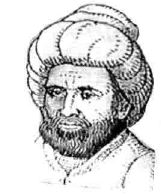

We know few details of al-Khwarizmi's life.
We know he worked at an academy where Greek philosophical and scientific works were translated. He and his colleagues also studied, and wrote on, algebra, geometry, and astronomy. Certainly al-Khwarizmi worked under the patronage of the Caliph.
His treatise on algebra, Hisab
al-jabr w'al-muqabala, was the most famous and important of all of al-Khwarizmi's works. It is the title of this text that gives us the word "algebra" and, in a
sense that we shall investigate more fully below, it is the first book to be written on algebra.
In al-Khwarizmi's own words, the purpose of the book is to teach:
After introducing the natural numbers, he discusses the solution of equations. His
equations are linear or quadratic and are composed of units (numbers), roots (x) and squares (x2). He first reduces an equation to one of 6 standard forms, using the operations of addition and subtraction, and then shows how to solve these standard types of equations. He uses both algebraic methods of solution and the geometric method of completing the square.
Al-Khwarizmi continues his study of algebra by examining how the laws of arithmetic extend to an arithmetic for his algebraic objects. For example he shows how to multiply out expressions such as (a + bx)(c + dx), although we should emphasize that al-Khwarizmi uses only words to describe his expressions, and no symbols are used.
The next part of al-Khwarizmi's Algebra consists of applications and worked examples. He then goes on to look at rules for finding the area of figures such
as the circle, and also finding the volume of solids such as the sphere, cone, and pyramid. This section on mensuration certainly has more in common with
Hindu and Hebrew texts than it does with any Greek work. The final part of the book deals with the complicated Islamic rules for inheritance, but require little
from the earlier algebra beyond solving linear equations.
Al-Khwarizmi's algebra is regarded as the foundation and cornerstone of the sciences. In a sense, al-Khwarizmi is more entitled to be called "the father of algebra" than Diophantus because al-Khwarizmi is the first to teach algebra in an elementary form and for its own sake, while Diophantus is primarily concerned with the theory of numbers.
Al-Khwarizmi also wrote a treatise on Hindu-Arabic numerals. The work describes the
Hindu place-value system of numerals based on 1, 2, 3, 4, 5, 6, 7, 8, 9, and 0. The first use of zero as a place holder in positional base notation was probably
due to al-Khwarizmi in this work.
He also wrote an important work on astronomy, covering calendars, calculating true positions of the sun, moon and planets, tables of sines and tangents, spherical astronomy, astrological tables, parallax and eclipse calculations, and visibility of the moon. Although his astronomical work is based on that of the Indians, and most of the values from which he constructed his tables came from Hindu astronomers, al-Khwarizmi must have been influenced by Ptolemy's work too.
Al-Khwarizmi wrote a major work on geography which give latitudes and longitudes for 2402 localities as a basis for a world map. The book, which is based
on Ptolemy's Geography, lists with latitudes and longitudes, cities, mountains, seas, islands, geographical regions, and rivers. The manuscript includes
maps which on the whole are more accurate than those of Ptolemy.
A number of minor works were written by al-Khwarizmi on topics such as the astrolabe, on which he wrote two works, on the sundial, and on the Jewish
calendar. He also wrote a political history containing horoscopes of prominent persons.
what is easiest and most useful in arithmetic, such as men constantly require in cases of inheritance, legacies, partition, lawsuits, and
trade, and in all their dealings with one another, or where the measuring of lands, the digging of canals, geometrical computations, and
other objects of various sorts and kinds are concerned.
This does not sound like the contents of an algebra text, and indeed only the first part of the book is a discussion of what we would today recognize as
algebra. However it is important to realize that the book was intended to be highly practical, and that algebra was introduced to solve real life problems that were
part of everyday life in the Islam empire at that time.